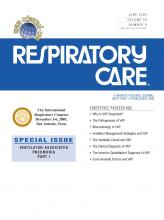Abstract
Historically, the relationship between the ventilator circuit and pulmonary infection was accepted as fact, without any scientific evidence. Hence the term, “ventilator”-associated pneumonia. Recent evidence, however, has demonstrated that the major sources of pneumonia in the ventilated patient are colonization of the gastrointestinal tract, with subsequent aspiration around the endotracheal tube cuff, and contamination by caregivers. In recent years, the relationship of respiratory care equipment to ventilator-associated pneumonia has been studied carefully. A number of clinical trials have demonstrated that routine changing of the ventilator circuit fails to impact the incidence of pneumonia in the ventilated patient. Additional studies evaluating the type of humidification device, type of suctioning device, and frequency of change of the devices have resulted in conflicting evidence. This paper reviews the role of the humidifier, ventilator circuit, and airway suctioning equipment on the pathogenesis and prevention of ventilator-associated pneumonia.
Footnotes
- Correspondence: Richard D Branson MSc RRT FAARC, Department of Surgery, University of Cincinnati, 231 Albert Sabin Way, Cincinnati OH 45267-0558. E-mail: richard.branson{at}uc.edu.
- Copyright © 2005 by Daedalus Enterprises Inc.







